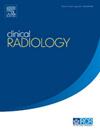Levator ani muscle assessment and its correlation with recurrence of pelvic organ prolapse: a pelvic floor MRI study
IF 2.1
3区 医学
Q2 RADIOLOGY, NUCLEAR MEDICINE & MEDICAL IMAGING
引用次数: 0
Abstract
Purpose
The levator ani muscle (LAM) plays a vital role in pelvic floor support. Understanding its influence on pelvic organ prolapse (POP) recurrence is essential for improving surgical techniques and postoperative care. This study hypothesized that patients with impaired preoperative LAM integrity, as assessed by pelvic floor MRI, had a higher risk of POP recurrence after pelvic floor repair surgery.
Methods
This retrospective study enrolled 38 patients with POP who underwent pelvic floor repair surgery. The patients were categorized into recurrence and non-recurrence groups based on gynecological examinations and Pelvic Floor Distress Inventory Questionnaire-20 (PFDI-20) scores. The structural and functional characteristics of the LAM were evaluated using preoperative static and dynamic MRI. A comparative analysis was performed between the two groups, and the Spearman correlation coefficient was used to quantitatively assess the correlation between LAM measurements and postoperative symptoms.
Results
The comparative analysis showed that the recurrence group had significantly more LAM injury, thinner puborectalis and iliococcygeus muscles, longer H-lines and M-lines, and larger levator hiatus compared to the non-recurrence group (p<0.05). Furthermore, significant correlations were found between LAM thickness and injury and PFDI-20 scores, with thinner and more severely injured LAM associated with more severe postoperative symptoms (p<0.05).
Conclusions
Incorporating pelvic floor MRI assessment of LAM into preoperative evaluation might help identify patients at higher risk for POP recurrence, allowing for optimized patient management and care.
提肛肌评估及其与盆腔脏器脱垂复发的相关性:盆底磁共振成像研究
目的提肛肌(LAM)在骨盆底支撑中起重要作用。了解其对盆腔器官脱垂(POP)复发的影响对提高手术技术和术后护理至关重要。本研究假设盆底MRI评估的术前LAM完整性受损的患者在盆底修复手术后POP复发的风险更高。方法回顾性研究38例行盆底修复手术的POP患者。根据妇科检查和盆底窘迫量表-20 (PFDI-20)评分将患者分为复发组和非复发组。术前使用静态和动态MRI评估LAM的结构和功能特征。对两组患者进行比较分析,并采用Spearman相关系数定量评价LAM测量值与术后症状的相关性。结果对比分析显示,复发组LAM损伤明显多于非复发组,耻骨直肠肌、髂尾骨肌较薄,h线、m线较长,提上睑肌裂孔较大(p < 0.05)。LAM厚度与损伤及PFDI-20评分之间存在显著相关性,LAM越薄、损伤越严重,术后症状越严重(p < 0.05)。结论将盆底MRI对LAM的评估纳入术前评估有助于识别POP复发风险较高的患者,从而优化患者管理和护理。
本文章由计算机程序翻译,如有差异,请以英文原文为准。
求助全文
约1分钟内获得全文
求助全文
来源期刊

Clinical radiology
医学-核医学
CiteScore
4.70
自引率
3.80%
发文量
528
审稿时长
76 days
期刊介绍:
Clinical Radiology is published by Elsevier on behalf of The Royal College of Radiologists. Clinical Radiology is an International Journal bringing you original research, editorials and review articles on all aspects of diagnostic imaging, including:
• Computed tomography
• Magnetic resonance imaging
• Ultrasonography
• Digital radiology
• Interventional radiology
• Radiography
• Nuclear medicine
Papers on radiological protection, quality assurance, audit in radiology and matters relating to radiological training and education are also included. In addition, each issue contains correspondence, book reviews and notices of forthcoming events.
 求助内容:
求助内容: 应助结果提醒方式:
应助结果提醒方式:


